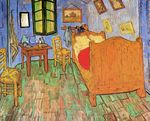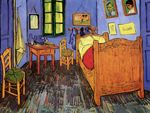ArtsVanGogh.com
Vincent van Gogh 1853-1890
Vincent van Gogh - The Bedroom 1889
/31 The Bedroom.jpg) The Bedroom |
From the Art Institute of Chicago :
Vincent van Gogh's three versions of this composition are the only record he made of the interior of the Yellow House, where he lived while he was in Arles in the south of France. The house embodied the artist's dream of a "Studio of the South," a community of like-minded artists working in harmony to create art for the future. The first version of The Bedroom (Van Gogh Museum, Amsterdam) was one of the paintings Van Gogh made to decorate the house in anticipation of the arrival of his first guest, Paul Gauguin. "It's just simply my bedroom," he wrote, "only here color is to do everything ... to be suggestive here of rest or of sleep in general. In a word, looking at the picture ought to rest the brain, or rather the imagination." Gauguin's stay at the Yellow House would be fraught with tension: after two months, Van Gogh's self-mutilation and Gauguin's flight back to Paris ended the Studio of the South. Van Gogh made this second version of The Bedroom about a year after the first, while he was living at an asylum in Saint-Rémy.
The Letters of Vincent van Gogh
To Theo van Gogh. Arles, Sunday, 21 October 1888.
My dear Theo,
Thank you for your letter and for the 50-franc note it contained. Thank you for having written me more about those Dutch artists’ painting.
I’ve had gas put in, in the studio and the kitchen, which is costing me 25 francs for installation. If Gauguin and I work every evening for a fortnight, won’t we earn it all back again? But since, what’s more, G. may come any day now, I’ll absolutely absolutely need at least another 50 francs.
I’m not ill, but I’d become so without any doubt if I didn’t take hearty food and if I didn’t stop painting for a few days. In fact, I’m once again nearly reduced to the state of madness of Hugo van der Goes in Emile Wauters’s painting. And if it wasn’t for the fact that I had something of a dual nature, something of both the monk and the painter, I should be — and that long since — utterly and entirely reduced to the above-mentioned state.
But even for all that, I don’t believe that my madness would be of the persecution kind, since my feelings in a state of excitement have more to do with preoccupations about eternity and eternal life.
But even so, I must be wary of my nerves, &c.
I only say that because you’d be wrong to believe that I’d have had the slightest wariness about these two Dutch painters. But in truth, it’s only after your second letter that I can form an idea of what they’re doing, and I’m very curious to see the photographs of their drawings. I have a great urge to write you a letter just so that you can have them read it, to explain once again why I myself believe in the south for the future and the present.
And at the same time to say how strongly I believe that we’re right to see in the Impressionist movement a tendency towards great things, and not only a school that would limit itself to making optical experiments. Similarly with those who do history painting, then, or at least have done it in the past; while there are some very bad history painters, like Delaroche and Delort, are there not also good ones, like E. Delacroix and Meissonier?
Well then, since I have the firm intention not to paint for at least 3 days, perhaps I’ll rest by writing to you and to them at the same time. Because you know that that interests me a good deal, the influence that Impressionism will have on Dutch painters and on Dutch art lovers.
Here’s very rough croquis of my last canvas. A row of green cypresses against a pink sky with a pale lemon crescent moon.
Foreground a piece of waste land, and some sand and a few thistles. Two lovers, the man pale blue with a yellow hat, the woman has a pink bodice and a black skirt. That makes the fourth canvas of the ‘poet’s garden’, which is the decoration for Gauguin’s bedroom.
It horrifies me to have to ask you for money again, but I can do nothing about it, and what’s more, I’m worn out again. However, I’d believe that the work that I’m doing while spending a little more will one day seem to us less costly than my previous work.
Besides, I’d already told you that if the thing had been possible, to do a deal with Thomas, I’d have had a strong desire to be able to put even 200 more into the work before Gauguin’s arrival.
As that couldn’t be done, I nevertheless pressed ahead as far as I could with what I had on the go, in a strong desire to be able to show him something new. And not to fall under his influence (because of course he’ll have an influence on me, I hope) before being able to show him beyond any doubt my own originality. He’ll see that anyway from the decoration as it is now.
Please, at least if the thing’s possible for you, send me another fifty francs right away; I don’t quite know how I’ll be able to get by otherwise. I’m pleased that you’ve read Tartarin again. Anyway. I hope you’ll be able to write to me no later than by return of post. I shake your hand firmly.
Ever yours,
Vincent


